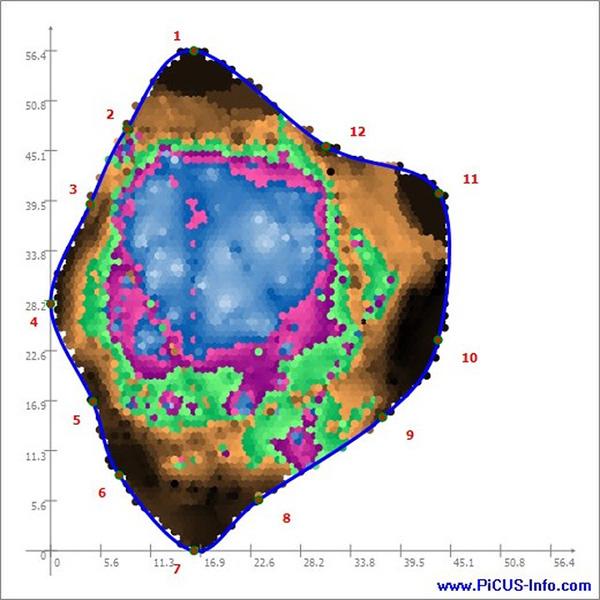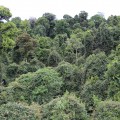
Tomogram showing areas of wood decay in a tree with an irregularly shaped trunk, based on sonic tomography with the PiCUS 3 Sonic Tomograph.
Living trees can rot from the inside out, leaving only a hollowed trunk. Wood rot in living trees can cause overestimates of global carbon pools, timber loss in forestry, and poor tree health. Understanding wood decay in forests is of special concern in the tropics because tropical forests are estimated to harbor 96% of the world’s tree diversity and about 25% of terrestrial carbon, compared to the roughly 10% of carbon held in temperate forests.
But how do foresters and researchers see into a living tree to measure wood decay? They use sound.
In a recently published article in Applications in Plant Sciences, a team of professors, teachers, and students established methods for using a sound wave technology called sonic tomography. Their methods were derived from measurements on more than 1,800 living trees of 173 tropical rainforest tree species in the Republic of Panama.
“We don’t yet know where internal decay and damage rank as a cause of tree mortality,” says Greg Gilbert, lead author and a researcher at the Smithsonian Tropical Research Institute in Panama and Professor and Chair of the Department of Environmental Studies at the University of California, Santa Cruz. “Most of the decay is hidden–the tomography now allows us to see how many apparently healthy trees are actually decayed inside.”
Sonic tomography sends sound waves through tree trunks. The longer it takes for a sound wave to traverse a trunk, the more decayed the wood. Based on the velocity of sound, the tomograph (PiCUS 3 Sonic Tomograph; Argus Electronic GmbH, Rostock, Germany) makes a color-coded image of a cross section of the trunk (see Figure).
Previous use of sonic tomography in forestry has focused on measurements in “typically shaped” trees with cylindrical trunks. However, tropical trees often have large buttresses, irregular trunk shapes, and prop roots that extend up the tree. The new study describes optimum placement of the sensors to avoid aberrant tomography results for the non-model tree shapes that populate the tropics and details how to analyze the tomograms to quantify areas of decayed and damaged wood.
The sonic tomography methods were developed and tested during an international field course for high school, college, and graduate students in the Republic of Panama and funded through the National Science Foundation. Gilbert and colleagues took students and their teachers into the field and used inquiry-based learning to teach molecular and field approaches to ecology, as well as foster an international pipeline to ecological research. Gilbert comments, “It was an exciting dive, with amazing people from diverse backgrounds, into the messy part of doing science–figuring out how best to do what you need in order to answer difficult questions.” All of the workshop participants contributed to the sonic tomography data collection and analysis for the article.
Fungi cause wood rot by entering a tree trunk and decaying wood from the inside out, releasing carbon back into the atmosphere as carbon dioxide. Gilbert explains that without a reliable method to detect missing wood, you cannot understand how trees are contributing to or moderating increasing levels of global atmospheric carbon, or how apparently healthy forests and tree species are responding to shifts in climate.
Gilbert’s research on wood decay is building toward a large study about how pathogens and diseases control the prevalence of tropical tree species. “The hypothesis is that species that are more susceptible to heart rot fungi will usually remain rare in the forest, and only those species that are resistant will become common,” says Gilbert. He and his colleagues are measuring and tracking tropical trees in the Smithsonian Tropical Research Institute’s long-term Forest Global Earth Observatory (ForestGEO) site on Barro Colorado Island in the Panama Canal.
Future work will continue validating sonic tomography technology for tropical tree systems using felled or already dead trees. Tropical trees are highly diverse in both form and function, and they are thus potentially distinct in their methodological requirements for sonic tomography. For example, this method does not work on palm species or any tree species that use internal tissues to store water.
Urban forestry also benefits from sonic tomography. Gilbert and colleagues with the Smithsonian Tropical Research Institute are collaborating with Panama City to use tomography to evaluate the health and property risks of Panama’s urban trees that may be decayed and vulnerable to snapping in high winds and heavy precipitation.





